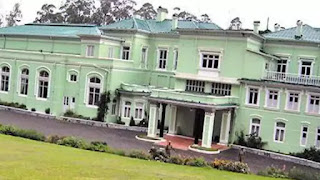During the British Raj, the cool climate of Ooty (Udhagamandalam) in the Nigiris attracted colonial administrators who sought refuge from the scorching heat of the Madras plains. The summer migration of the Madras Presidency government to Ooty officially began in the mid-19th century, inspired by similar seasonal relocations of the British Viceroy’s office from Calcutta to Shimla. Though initially temporary, the move became a regular affair.
 |
| Duke of Buckinham en.wikipedia.org |
Above image: Third Duke of Buckingham and Chandos, (10 September 1823 1889) a British soldier, politician and administrator of the 19th century, was a close friend and served as the secretary of state for the colonies from 1867 to 1868 and governor of Madras from 1875 to 1880. He had the Governor's Residence built in Ooty, Nilgiris
 |
| Raj Bhavan (Gov. residence) Ooty. indiatimes.com |
 |
| Fomer CM Madras Presidency, C Rajagopala Chari |
Above image: C. Rajagopalachary, lawyer, patriot and first Gov. General of India after independence and former CM of Madras Presidency, Comprising Tamil Nadu, Kerala, Karnataka and composite Andhra Pradesh. A visionary and an honest and effective administrator.......
During the British Raj, the cool climate of Ooty (Udhagamandalam) in the Nigiris attracted colonial administrators who sought refuge from the scorching heat of the Madras plains. The summer migration of the Madras Presidency government to Ooty officially began in the mid-19th century, inspired by similar seasonal relocations of the British Viceroy’s office from Calcutta to Shimla. Though initially temporary, the move became a regular affair.
.jfif) |
| Statue of Lord Elphinstone en.wikipedia.org |
Above image: Mount Stuart Elphinstone's memorial in St Paul's Cathedral, London...........
The earliest shift was unofficial—Governor Lord Elphinstone moved his secretariat to Ooty in 1840 without authorization, sparking criticism from the presidency administration. Despite opposition from the India Office in London, the practice gained ground. By 1869, infrastructure improvements like the Napier Bridge in Chennai and early development in Ooty made seasonal administration from the hills more practical.
 |
| Chennai (Madras) to Ooty, TN.blog.savaari.com |
The stone house built by John Sullivan became the makeshift secretariat, and the first formal council meeting in Ooty was held on July 8. Over time, grand colonial buildings were erected, including the Raj Bhavan, constructed in 1877 by the Duke of Buckingham at great expense. The town also hosted key events, such as the 1913 Cauvery water-sharing talks between Mysore and the Madras Presidency.
This seasonal shift, however, came at a steep financial cost. Maintaining dual establishments and transporting personnel, files, and resources became increasingly burdensome. The hill station functioned as the de facto summer capital for nearly 67 years, with some officials overstaying up to eight months. Despite growing criticism and petitions to the British Parliament, the practice continued.
It was finally in 1937 that the Premier of Madras Presidency, C. Rajagopalachari (Rajaji), a patriot and administrator with a keen sense of austerity, ended the costly and inefficient tradition. Believing it to be a waste of public money during a time of growing nationalist sentiment and economic challenges, Rajaji ordered the closure of the annual summer migration, thus bringing an end to Ooty’s legislative chapter.
Navrangindia.in/2022/07/ooty-summer-exodus-of-govt-offices-from.html
https://www.deccanherald.com/content/617911/ooty-its-best.html









